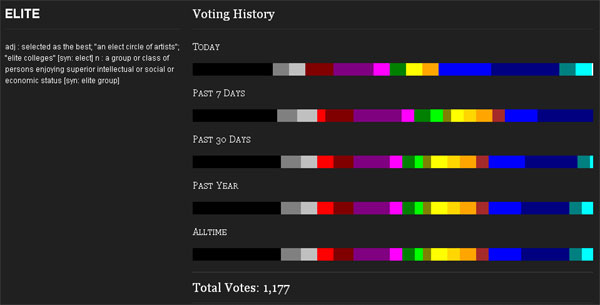 Cymbolism is a really cool new experimental web site that, in its own words, “attempts to quantify the association between colors and words, making it simple for designers to choose the best colors for the desired emotional effect.” It does that by asking visitors to match words to the colors they evoke and then charting the results.
Cymbolism is a really cool new experimental web site that, in its own words, “attempts to quantify the association between colors and words, making it simple for designers to choose the best colors for the desired emotional effect.” It does that by asking visitors to match words to the colors they evoke and then charting the results.
When visiting the site, users are confronted with a word, which is defined for them, as well as a block of 19 basic colors and asked to click on the color that the word makes them most think about. Right now, the site has 178 words in its database (visitors can suggest new ones) and has recorded nearly 250,000 votes.
Each word gets a page that breaks out the results using colored frequency strips to display votes from the past 7 days, 30 days, year, and all time (the latter two being the same for now since the site has only been operation a couple of months).
Cymbolism could be an invaluable tool for designers trying to pick color schemes that match a concept. How do you use color to make your web site communicate summer fun, for example? According to Cymbolism, use red, pink or yellow for fun, and a shade of yellow or green for summer.
The experiment reminds us of Brand Tags, which asks people to match words or phrases to corporate logos and then creates a tag cloud based on the responses.

Found via information aesthetics.
Frequently Asked Questions (FAQs) about Cymbolism and the Color of Language
What is Cymbolism and how does it relate to language?
Cymbolism is a tool that attempts to quantify the association between colors and words, effectively creating a color-language relationship. It allows users to associate words with colors, thereby creating a database of how different people perceive different words in terms of color. This can be used in various fields such as marketing, design, and psychology to understand how color can influence perception and communication.
How does Cymbolism work?
Cymbolism works by presenting users with a word and asking them to associate it with a color. The results are then compiled into a database, creating a comprehensive color-word association chart. This chart can be used to understand the general perception of words in terms of color.
Can Cymbolism be used in marketing and design?
Yes, Cymbolism can be a valuable tool in marketing and design. By understanding the color associations of certain words, marketers and designers can use this information to create more effective and impactful designs and campaigns. For example, if a word associated with a product or brand is strongly linked to a certain color, incorporating that color into the design could enhance the product’s appeal.
Is there a scientific basis for Cymbolism?
While Cymbolism is not a scientific tool in itself, it does draw on principles from psychology and linguistics. The association between colors and words or emotions is a well-studied phenomenon in psychology, and Cymbolism uses this concept to create its color-word association database.
How can I use Cymbolism?
You can use Cymbolism by visiting the website and participating in the color-word association process. By doing so, you contribute to the growing database of color-word associations. You can also use the results to inform your own understanding of color and language.
Can Cymbolism help me understand color psychology?
Yes, Cymbolism can provide insights into color psychology. By understanding how different people associate colors with words, you can gain a better understanding of how color can influence perception and emotion.
Is Cymbolism a reliable tool?
Cymbolism is a tool that relies on user input, so its reliability can vary. However, it does provide a unique perspective on color-word associations and can be a valuable resource for those interested in color psychology, marketing, and design.
Can Cymbolism be used in other languages?
Currently, Cymbolism is primarily focused on English words. However, the concept could potentially be applied to other languages, providing a fascinating insight into cultural differences in color-word associations.
How can Cymbolism benefit designers?
Designers can use Cymbolism to understand how different colors can evoke certain emotions or associations. This can help them create more effective and impactful designs.
Can Cymbolism predict color trends?
While Cymbolism is not designed to predict color trends, it can provide insights into how people perceive and associate colors. This information could potentially be used to anticipate color trends.
Before joining Jilt, Josh Catone was the Executive Director of Editorial Projects at Mashable, the Lead Writer at ReadWriteWeb, Lead Blogger at SitePoint, and the Community Evangelist at DandyID. On the side, Josh enjoys managing his blog The Fluffington Post.
Published in
·APIs·Business·Cloud·Entrepreneur·Libraries·Programming·Software·Software Development·Web·October 13, 2014



